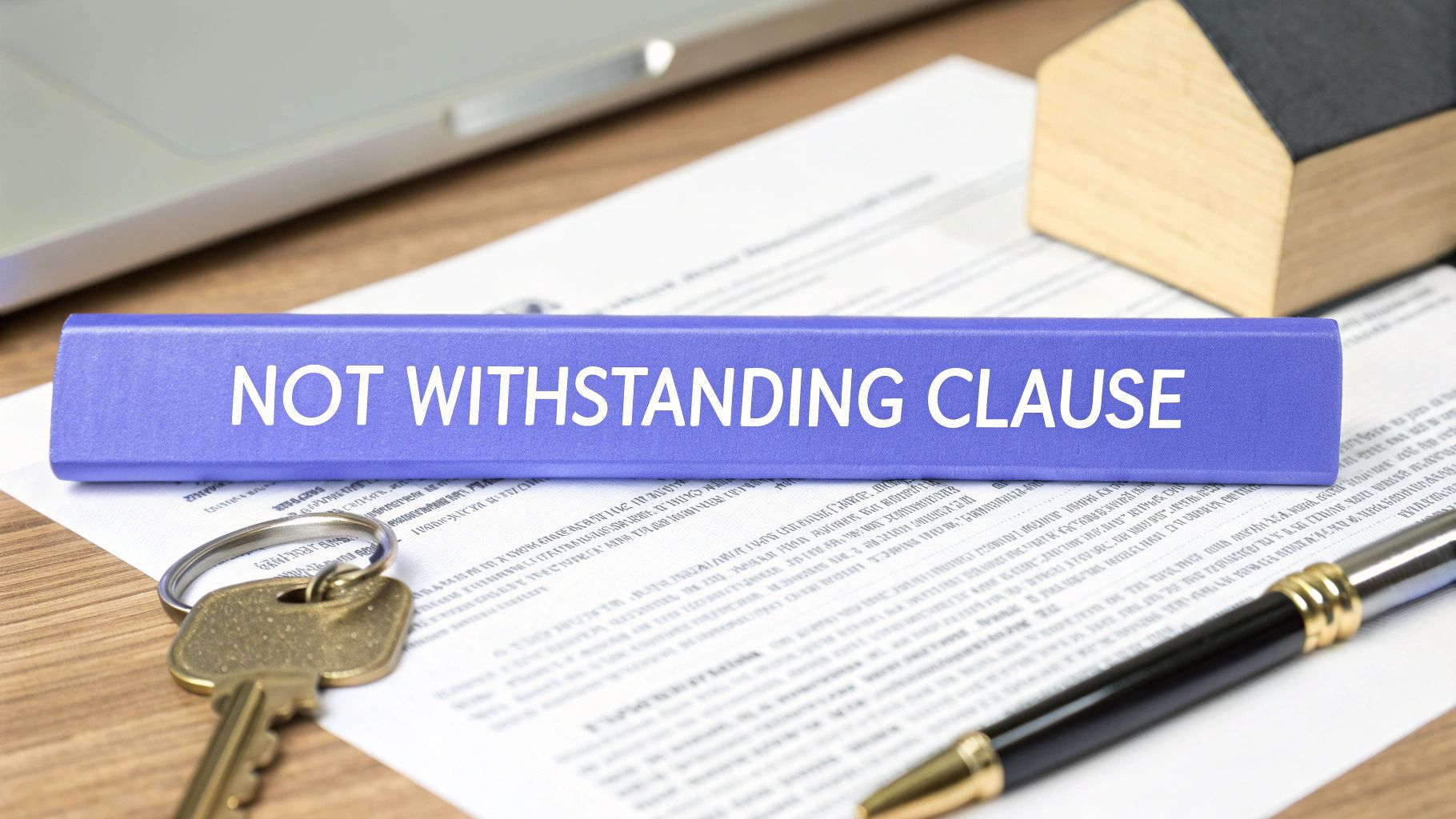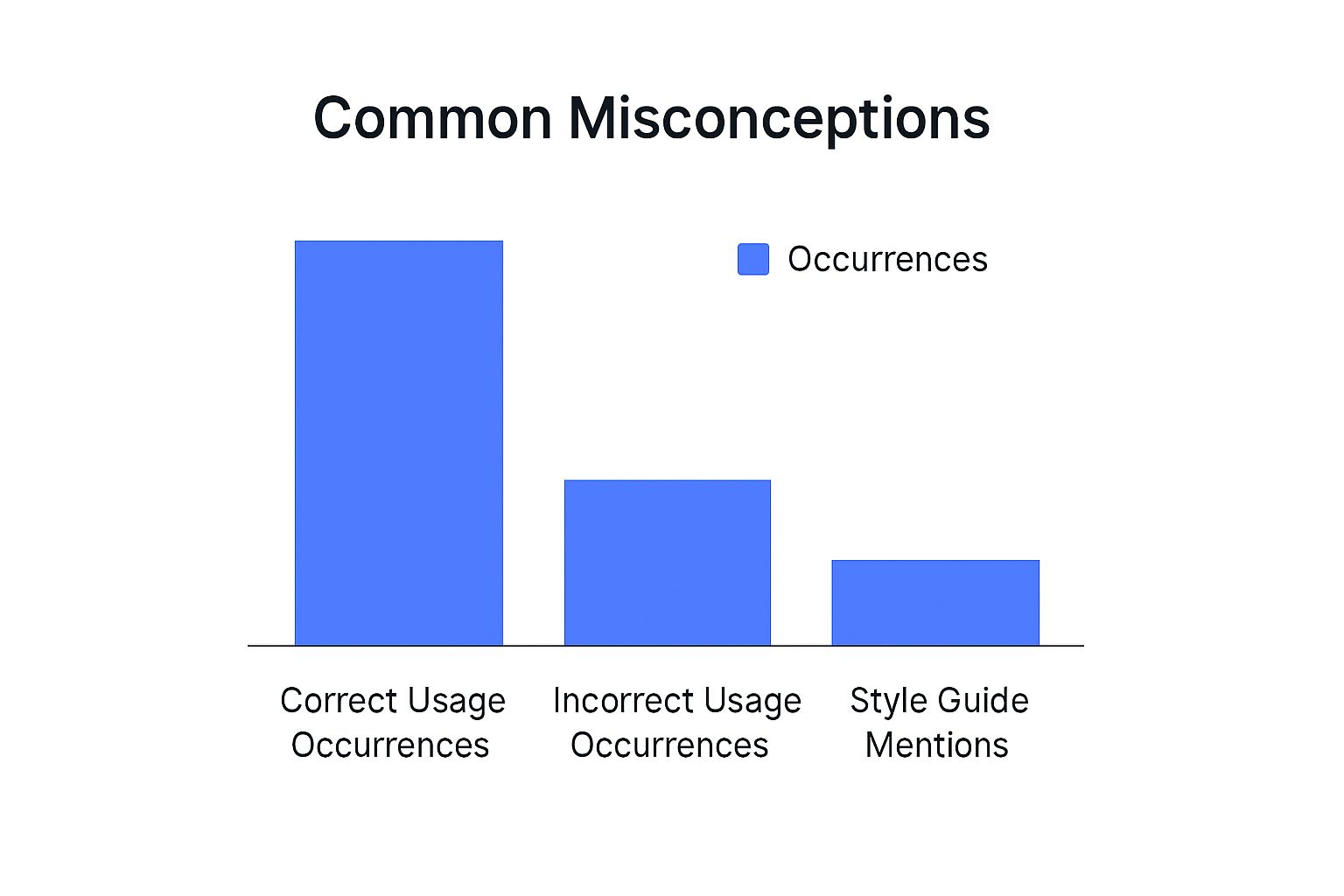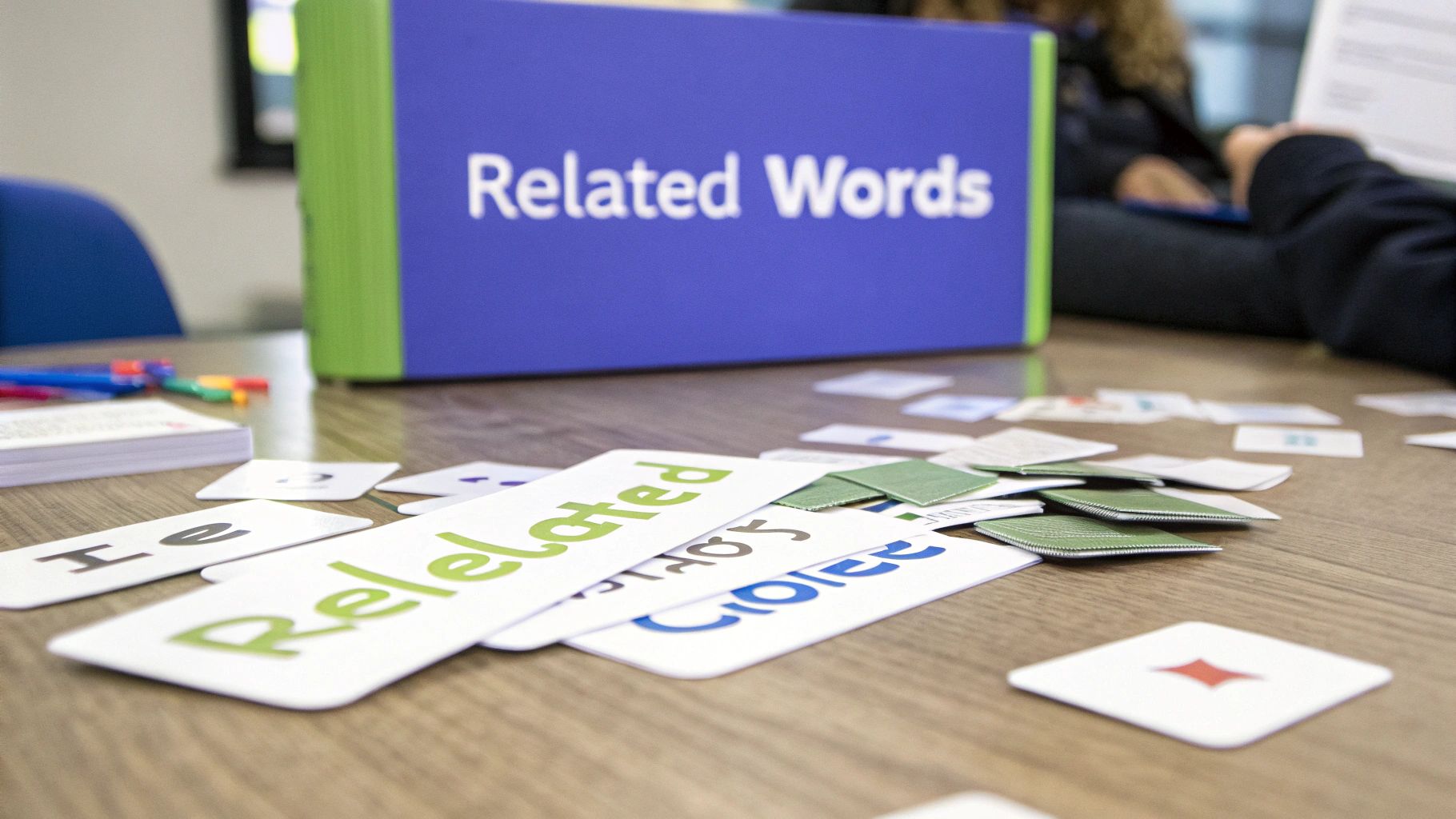
In plain English, the meaning of notwithstanding is simply "in spite of" or "despite." Think of it as a power word in a contract, a trump card that signals one rule is more important than another. It’s like a master key that overrides any conflicting clauses it comes across.
Unlocking the Power of Notwithstanding

Ever run into a rule, only to find another that carves out a special exception just for you? That’s precisely what “notwithstanding” does in legal and formal writing. It’s a specialized tool for creating a clear hierarchy between rules, which helps prevent confusion and ensures a specific condition is honored above all others.
Imagine a concert venue with a strict “no entry after 9 PM” policy. But your special pass says, “Notwithstanding the general entry policy, VIP ticket holders may enter at any time.” That single phrase gives you a privilege that steamrolls the standard rule. The word itself establishes priority, telling you to ignore a conflicting instruction and follow this new one instead. This is critical in complex documents where contradictions could otherwise spiral into major disagreements.
To give you a quick reference, here's a simple breakdown of how "notwithstanding" works in different contexts.
Notwithstanding At a Glance
| Context | Plain English Meaning | Example Usage |
|---|---|---|
| Contracts | "Even if another clause says something different..." | "Notwithstanding Section 5.1, the Seller must deliver all goods by June 30." |
| Legislation | "This law applies regardless of any other conflicting laws..." | "Notwithstanding any other provision of law, this tax credit shall be available." |
| Formal Agreements | "Despite what was agreed to earlier..." | "Notwithstanding the prior agreement, the new deadline is final." |
This table shows how the word acts as a signal, telling the reader which instruction to follow when two rules clash.
Establishing a Clear Hierarchy
At its core, the primary job of this term is to resolve potential conflicts before they ever become a problem. It works on a simple principle: the clause it introduces takes precedence. Period. This function is essential for a few key reasons:
- It Creates Certainty: Ambiguity is the enemy of any good legal document. This word removes it by clearly stating which rule wins.
- It Allows for Exceptions: It provides a clean way to make specific exceptions without having to rewrite an entire document.
- It Prioritizes Critical Terms: It ensures that the most important clauses—like payment terms or confidentiality—are shielded from being accidentally weakened by other sections.
By signaling a clear override, "notwithstanding" acts like a legal traffic cop, directing you to follow one specific path while ignoring any conflicting signals. This prevents interpretive gridlock and makes sure the document's core intentions are upheld.
Grasping this simple concept is the first step to mastering its use. To dig deeper, our detailed definition of notwithstanding provides more context and examples for anyone navigating complex agreements. Ultimately, this word isn't just jargon; it’s a vital instrument for creating clear, enforceable, and unambiguous documents.
How “Notwithstanding” Commands Legal Contracts
In the world of legal agreements, words carry immense weight. But “notwithstanding” isn’t just another word—it’s a power move. Lawyers use it to establish a clear pecking order within a contract, essentially crowning one clause as the undisputed ruler over any others that might get in its way. This is how you protect your most essential terms from being watered down or accidentally canceled out by other language in the document.
Think of it as a contractual trump card. A contract might lay out a dozen general rules, but a notwithstanding clause acts as a specific override for something that absolutely cannot be compromised. It’s the perfect tool for shielding the most critical parts of your deal.
Prioritizing What Truly Matters
Some parts of an agreement are just too important to leave open to interpretation. These are the mission-critical areas where you’ll most often find "notwithstanding" stepping in to take charge.
- Payment Terms: Imagine a clause that says, “Notwithstanding Section 4.2 (Reimbursement Policy), all invoices for emergency services must be paid within 15 days.” This carves out an exception to ensure urgent work gets paid for quickly, bypassing the slower, standard payment cycles.
- Confidentiality: A company might state, “Notwithstanding any other provision in this agreement, the confidentiality obligations in Section 8 shall survive the termination of this contract indefinitely.” This keeps sensitive information locked down forever, no matter what other termination clauses say.
- Liability Limits: A software vendor could include, “Notwithstanding the general warranty provisions, the Seller’s liability for data loss is capped at $50,000.” This creates a very specific financial shield that takes precedence over any broader promises made in the warranty.
The real job of a "notwithstanding" clause is to kill ambiguity. It sends a clear message to everyone involved: "When it comes to this specific topic, ignore everything else you’ve read and follow this one rule." That kind of precision is what makes an agreement truly enforceable.
The Danger of a Vague Override
One of the riskiest phrases you’ll see in a contract is “notwithstanding anything to the contrary.” It sounds powerful and all-encompassing, but it often creates more problems than it solves. It forces everyone to play a guessing game about which of the dozens of preceding clauses it’s meant to override, which is a recipe for expensive legal fights.
This lack of precision is a surprisingly common source of conflict. In fact, an analysis of contract disputes found that a staggering 12% of litigated cases in the US and UK involved fights over which clause took precedence—including those introduced by a vague "notwithstanding."
The smarter, safer path is always specificity. Instead of a broad, sweeping statement, pinpoint the exact clause you intend to supersede. This level of clarity is a cornerstone of strong contract drafting, much like ensuring there's a clear exchange of value—a topic you can explore further by understanding what is a consideration in a contract.
Seeing Notwithstanding in Real-World Scenarios

Theory is one thing, but the true meaning of notwithstanding really clicks when you see it in action. This isn't just a stuffy term for high-stakes legal battles; it’s a practical tool used in everyday agreements to bring clarity and head off potential fights before they even begin.
Let's shift from abstract concepts to concrete examples. Once you see how "notwithstanding" functions in different documents, you'll understand its power as a master clause that creates specific, binding exceptions.
Example 1: The Pet-Friendly Lease
Picture a standard apartment lease. Section 8 has a crystal-clear "no pets" policy. But what if the landlord agrees to let you keep your cat? Instead of rewriting the entire lease, they can add a simple addendum.
"Notwithstanding Section 8 of this Lease Agreement, the Tenant is permitted to keep one domestic cat, 'Whiskers,' on the premises."
Think of "notwithstanding" as a surgical tool. It doesn't throw out the entire "no pets" rule. It just carves out a single, precise exception for your cat, Whiskers. This directly overrides Section 8 in this one instance, leaving no room for confusion or a future dispute.
Example 2: The Urgent Project Payment
Imagine you’ve signed a service contract. The standard payment terms in Section 4.3 state all invoices are paid within 30 days (Net 30). But you're starting a high-priority project and can't wait a month to be reimbursed for expenses.
You negotiate a special clause for this specific project:
- "Notwithstanding the Net 30 payment terms defined in Section 4.3, all pre-approved travel and material expenses for the 'Alpha Project' shall be reimbursed within 7 business days of invoice receipt."
This doesn't upend the company's normal payment cycle. It simply creates a fast lane for a specific set of costs tied to the Alpha Project. You get paid back quickly, and the company’s standard Net 30 policy remains in effect for everything else.
In both scenarios, "notwithstanding" plays the same crucial role: it creates a clear hierarchy. It's a signal to the reader that says, "Stop. This rule is special, and it trumps that other rule we mentioned." It’s this kind of precision that makes agreements work.
Why Precision Matters in Global and Formal Use
When you're dealing with contracts that cross borders, the meaning of notwithstanding takes on a whole new level of importance. In major English-speaking legal systems like the United States, the UK, and India, this single word is a workhorse in high-stakes government orders and massive commercial deals. Its job is always the same—to signal an exception—but getting it right requires absolute precision.
Think about it: when a deal involves parties from different countries, the potential for misinterpretation shoots up. Any fuzziness around which clause trumps another can spark ugly, complicated, and expensive legal battles. This isn't just a fancy word; it's a powerful tool for managing risk and making sure everyone is on the same page, regardless of their legal system. It acts as a bridge of certainty over a river of potential conflict.
A Specialized Tool for Formal Agreements
"Notwithstanding" isn't just a bit of legal flair; it's a specialized tool used with purpose. Its importance in formal writing is backed by hard numbers. One analysis found the word pops up in 1 out of every 175 sentences in U.S. and UK legal documents. Compare that to its appearance in just 1 in 500 sentences in general English, and you can see how vital it is in formal agreements. You can dig into more of these usage patterns on Trinka.ai.
This frequency shows that legal drafters don't use it lightly. They rely on it to navigate complex legal webs and shield critical provisions from being accidentally overridden. Using it correctly is a sign of a skilled writer.
The bottom line for any formal or global document is that ambiguity is your enemy. A lazy phrase like "notwithstanding anything to the contrary" is a gamble you can't afford, especially when legal interpretations already vary from one country to the next.
Ultimately, mastering "notwithstanding" is part of a bigger picture: the need for total clarity when you're working with complex legal terms. For those looking to demystify other confusing language, you might find our guide on common legal jargon explained helpful. When used with care, "notwithstanding" makes your document stronger, clearer, and more defensible—no matter where in the world it’s being read.
Choosing Smarter Alternatives for Clearer Writing
While "notwithstanding" is a powerful word, it’s not always the right tool for the job. Let's be honest—its formal, legalistic tone can feel stiff and out of place in everyday writing. Overusing it can turn an otherwise clear document into a dense, unreadable mess. Good writing is all about picking the right word for the situation, and clarity should always win over unnecessarily complex language.
Often, you can get the same point across with a much simpler word. Before you reach for this legal heavyweight, take a moment to ask if a more common alternative would work better. For most situations outside of a formal legal contract, words like "despite," "in spite of," or "even though" do the trick perfectly and are far more accessible to your reader.
Knowing When to Use Simpler Terms
When it comes to everyday business communication—think emails, reports, or internal memos—clarity is king. In these contexts, dropping a "notwithstanding" can come across as overly formal, or worse, a bit pretentious. It's often better to just rephrase the sentence for a smoother, more natural flow.
Just look at the difference:
- A bit stiff: Notwithstanding the project delays, the team met its quarterly target.
- Much clearer: Despite the project delays, the team met its quarterly target.
The second option is just as professional, but it’s more direct and easier for anyone to understand in a heartbeat.
To help you decide which word fits best, this table breaks down the common alternatives.
Choosing the Right Word: Notwithstanding vs. Alternatives
This table compares 'notwithstanding' with its common alternatives, helping you choose the most precise term for your context.
| Term | Best Used For | Level of Formality | Clarity Risk |
|---|---|---|---|
| Notwithstanding | Legal contracts and formal agreements to override a specific clause. | Very High | High, if used vaguely. Can sound archaic in informal writing. |
| Despite / In Spite Of | General business and everyday writing to show contrast. | Medium | Low. These are widely understood and clear. |
| Although / Even Though | Connecting contrasting ideas within a sentence. | Low-Medium | Low. Very common and easily understood. |
| However / Nevertheless | Transitioning between two opposing statements or paragraphs. | Medium | Low. Excellent for creating logical flow. |
Ultimately, the goal is to communicate, not to show off a large vocabulary. Using a simpler word like "despite" or "however" is often the smarter, more effective choice.
The Most Important Rule for Using Notwithstanding
When you absolutely need the legal punch of "notwithstanding," there's one rule you can't ignore: be specific. The single biggest mistake I see people make is using the vague, catch-all phrase, “notwithstanding anything to the contrary.”
This kind of lazy phrasing is a recipe for disaster. It forces everyone to guess which parts of the agreement you meant to cancel out, creating ambiguity that can easily lead to expensive legal fights down the road.
The right way to do it is to explicitly name the specific clause you're overriding. For example: “Notwithstanding Section 4.2 of this agreement, all deliveries must be completed by July 31.”
This is crystal clear. There’s no room for misinterpretation.
This infographic shows just how big the gap is between best practices and common mistakes, highlighting how often style guides warn against vague usage.

The data speaks for itself. While imprecise use is common, the experts consistently push for precision. By being explicit, you kill confusion, slash your risk, and create a document that's not only professional but also solid and defensible. This discipline is what separates amateur drafting from professional, enforceable writing.
Common Questions About Using Notwithstanding
 Even when you feel like you've got a handle on "notwithstanding," some practical questions always seem to pop up when it's time to actually use it. This section cuts right to the chase, offering quick answers to the most common sticking points. Think of it as a handy reference to clear up any lingering confusion and help you navigate these situations with confidence.
Even when you feel like you've got a handle on "notwithstanding," some practical questions always seem to pop up when it's time to actually use it. This section cuts right to the chase, offering quick answers to the most common sticking points. Think of it as a handy reference to clear up any lingering confusion and help you navigate these situations with confidence.
Can I Use Notwithstanding in an Email?
You technically can, but it's almost always overkill. "Notwithstanding" is a heavyweight legal term that can come across as stiff, overly formal, or even aggressive in day-to-day business emails. It really belongs in formal documents where legal precision is the name of the game—think contracts, official policies, or detailed proposals.
In an email, you’re better off using simpler, more natural language that gets the same point across. For instance:
- "Despite the shipping delay…"
- "Even though the budget was tight…"
- "However, we need to prioritize this task…"
These alternatives keep your tone professional but still approachable.
What Is the Biggest Mistake People Make?
The most common—and potentially costly—mistake is being vague. Dropping a blanket phrase like "notwithstanding anything to the contrary" into a document is a recipe for disaster. It creates a guessing game, forcing everyone to figure out which clauses are being overridden. That kind of ambiguity is a magnet for disputes.
The gold standard is always to be explicit. Precision is your best defense against misinterpretation. Always state exactly which section or clause you are overriding to leave no room for doubt.
For example, a clear statement would be: “Notwithstanding Section 7.2 of this Agreement, the payment terms in Section 10 shall apply.” No guesswork needed.
Is Notwithstanding the Same As Subject To?
No, they are functional opposites. Confusing them can completely flip the meaning of an agreement, so it's critical to know the difference.
Think of it this way:
"Notwithstanding" is a trump card. It signals that its clause wins any conflict with other clauses. It carves out an exception that overrules another part of the agreement.
"Subject to" does the exact opposite. It signals that its clause is weaker than or limited by another clause. It's like saying, “This rule applies, but just know that another, more powerful rule can override it.”
Struggling to decode dense contracts and confusing legal agreements? Let Legal Document Simplifier do the heavy lifting. Our AI-powered platform instantly transforms complex documents into clear, actionable summaries, highlighting key terms, deadlines, and risks so you can make decisions with confidence. Stop guessing and start understanding. Try Legal Document Simplifier today.